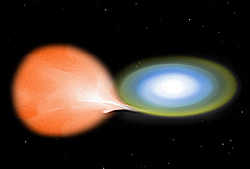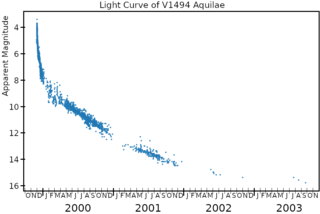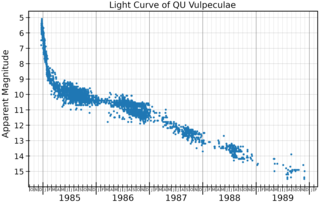
A nova is a transient astronomical event that causes the sudden appearance of a bright, apparently "new" star, that slowly fades over several weeks or many months. Causes of the dramatic appearance of a nova vary, depending on the circumstances of the two progenitor stars. All observed novae involve a white dwarf in a close binary system. The main sub-classes of novae are classical novae, recurrent novae (RNe), and dwarf novae. They are all considered to be cataclysmic variable stars.

Beta Centauri, officially called Hadar, is a triple star system in the southern constellation of Centaurus. The system's combined apparent visual magnitude of 0.61 makes it the second-brightest object in Centaurus and one of the brightest stars in the night sky. According to parallax measurements from the astrometric Hipparcos satellite, the distance to this system is about 390 light-years.

T Pyxidis is a recurrent nova and nova remnant in the constellation Pyxis. It is a binary star system and its distance is estimated at about 4,783 parsecs from Earth. It contains a Sun-like star and a white dwarf. Because of their close proximity and the larger mass of the white dwarf, the latter draws matter from the larger, less massive star. The influx of matter on the white dwarf's surface causes periodic thermonuclear explosions to occur.

T Aurigae was a nova, which lit up in the constellation Auriga in 1891. Thomas David Anderson, an amateur astronomer in Edinburgh, reported that he was "almost certain" he saw the nova at 02:00 UT on 24 January 1891, when it was slightly brighter than χ Aurigae. He mistook the star for 26 Aurigae, although he noted to himself that it seemed brighter than he remembered it being. He saw it twice more during the following week. On 31 January 1891 he realized his mistake, and wrote a note to Ralph Copeland reporting his discovery. Professor Copeland immediately reported the discovery via telegram to William Huggins, who made the first spectroscopic observations of T Aurigae on 2 February 1891, when the star was a magnitude 4.5 object. T Aurigae was the first nova to be observed spectroscopically.
BT Monocerotis was a nova, which lit up in the constellation Monoceros in 1939. It was discovered on a spectral plate by Fred L. Whipple on December 23, 1939. BT Monocerotis reached a brightness of 4.5 mag, making it visible to the naked eye. Its brightness decreased after the outbreak by 3 magnitudes in 182 days, making it a "slow nova". The light curve for the eruption had a long plateau period.

DK Lacertae was a nova, which lit up in the constellation Lacerta in 1950. The nova was discovered by Charles Bertaud of the Paris Observatory on a photographic plate taken on 23 January 1950. At the time of its discovery, it had an apparent magnitude of 6.1. DK Lacertae reached peak magnitude 5.0, making it easily visible to the naked eye.

V1494 Aquilae or Nova Aquilae 1999 b was a nova which occurred during 1999 in the constellation Aquila and reached a brightness of magnitude 3.9 on 2 December 1999. making it easily visible to the naked eye. The nova was discovered with 14×100 binoculars by Alfredo Pereira of Cabo da Roca, Portugal at 18:50 UT on 1 December 1999, when it had a visual magnitude of 6.0.

QU Vulpeculae, also known as Nova Vulpeculae 1984 Number 2, was the second nova which occurred in 1984 in the constellation Vulpecula. It was discovered by Peter Collins, an amateur astronomer from Cardiff, California at 22:08 UT on 22 December 1984. At the time of its discovery, the nova's apparent magnitude was 6.8. By the next night, Collins reported its brightness had increased to magnitude 5.6, making it visible to the naked eye.

V842 Centauri, also known as Nova Centauri 1986, was a nova which occurred in 1986 in the constellation Centaurus. It was discovered by Robert H. McNaught of Siding Spring Observatory in Australia, on 22 November 1986. At the time of its discovery, it had an apparent magnitude of 5.6. It reached a peak magnitude of 4.6 one and a half days later, making it easily visible to the naked eye.

Rho Centauri, Latinized from ρ Centauri, is a binary star system in the southern constellation of Centaurus. It is visible to the naked eye as a blue-white hued point of light with a combined apparent visual magnitude of +3.97. The system is located approximately 276 light years from the Sun based on parallax, and is drifting further away with a radial velocity of around +15 km/s. It is a proper motion member of the Lower-Centaurus Crux sub-group in the Scorpius-Centaurus OB association, the nearest such association of co-moving massive stars to the Sun.
HD 102776, also known by its Bayer designation j Centauri, is a star in the constellation Centaurus.
3 Centauri is a triple star system in the southern constellation of Centaurus, located approximately 300 light years from the Sun. It is visible to the naked eye as a faint, blue-white hued star with a combined apparent visual magnitude of 4.32. As of 2017, the two visible components had an angular separation of 7.851″ along a position angle of 106°. The system has the Bayer designation k Centauri; 3 Centauri is the Flamsteed designation. It is a suspected eclipsing binary with a variable star designation V983 Centauri.
F Centauri is a suspected astrometric binary star system in the southern constellation of Centaurus. It has a reddish hue and is visible to the naked eye with an apparent visual magnitude that fluctuates around +5.01. The system is located at a distance of approximately 450 light years from the Sun based on parallax, and it has an absolute magnitude of −0.87. O. J. Eggen flagged this star as a member of the Hyades Supercluster.

V339 Delphini or Nova Delphini 2013 is a bright nova star in the constellation Delphinus. It was discovered on 14 August 2013 by amateur astronomer Koichi Itagaki in Japan and confirmed by the Liverpool Telescope on La Palma. The nova appeared with a magnitude 6.8 when it was discovered and peaked at magnitude 4.3 on 16 August 2013. A nova is produced by the fusion of accumulated material on the white dwarf nova progenitor acquired from its companion star. The nova system is thus a binary star, and a classical nova. The white dwarf is a carbon-oxygen white dwarf, with an estimated mass of 1.04±0.02 M☉. There is not yet a consensus about what the binay's orbital period is; estimates range from 3.15 hours to 6.43 hours.

KT Eridani was a bright nova in the constellation Eridanus that produced an outburst in 2009. It was the first classical nova ever detected in that constellation. The nova was discovered at 12:52 UT on 25 November 2009 by K. Itagaki at Yamagata, Japan with a 21 cm patrol telescope. At the time of its discovery, it was a magnitude 8.1 object. The discovery occurred after the nova's peak brightness, but the All Sky Automated Survey system had detected the nova on three earlier occasions, allowing a more complete light curve to be produced. The peak magnitude, 5.4, was seen at 15:10 UT on 14 November 2009.

V5856 Sagittarii, also known as Nova Sagittarii 2016 Number 4, was the 4th and brightest nova that occurred in the constellation Sagittarius during 2016. It was discovered by the All Sky Automated Survey for SuperNovae on 25.02 October 2016, at which time it had an apparent visual magnitude of 13.7. It was independently discovered by Yukio Sakurai of Mito, Ibaraki, Japan on 26.38 October 2016, by which time it had reached magnitude 10.4. It reached its peak brightness of magnitude 5.4, making it visible to the naked eye, on 8 November 2016. The nova occurred within a region of the sky monitored by the OGLE microlensing experiment, and that group reported that no star brighter than magnitude 22 was seen at the nova's position prior to its eruption.
BV Centauri is a cataclysmic variable binary star in the constellation Centaurus. It is a dwarf nova, and undergoes rapid increases in brightness that are recurrent with a mean period of 150 days. This period seems to have increased in the last few decades. During quiescence, its visual apparent magnitude is about 13, with variations of a few tenths of magnitude over an orbit due to differences in the star's visible surface area, brightening to a maximum magnitude of 10.7 during outbursts. From its luminosity, it is estimated that the system is about 500 parsecs (1,600 ly) away from Earth. A Gaia parallax of 2.81 mas has been measured, corresponding to about 360 pc.

V392 Persei, also known as Nova Persei 2018, is a bright nova in the constellation Perseus discovered on April 29, 2018. It was previously known as a dwarf nova.

Nova Reticuli 2020 is a naked eye nova in the constellation Reticulum discovered on July 15, 2020. Previously it was known as a VY Sculptoris type object with the designation MGAB-V207. In 2020, this object was assigned the variable star designation YZ Reticuli.


















